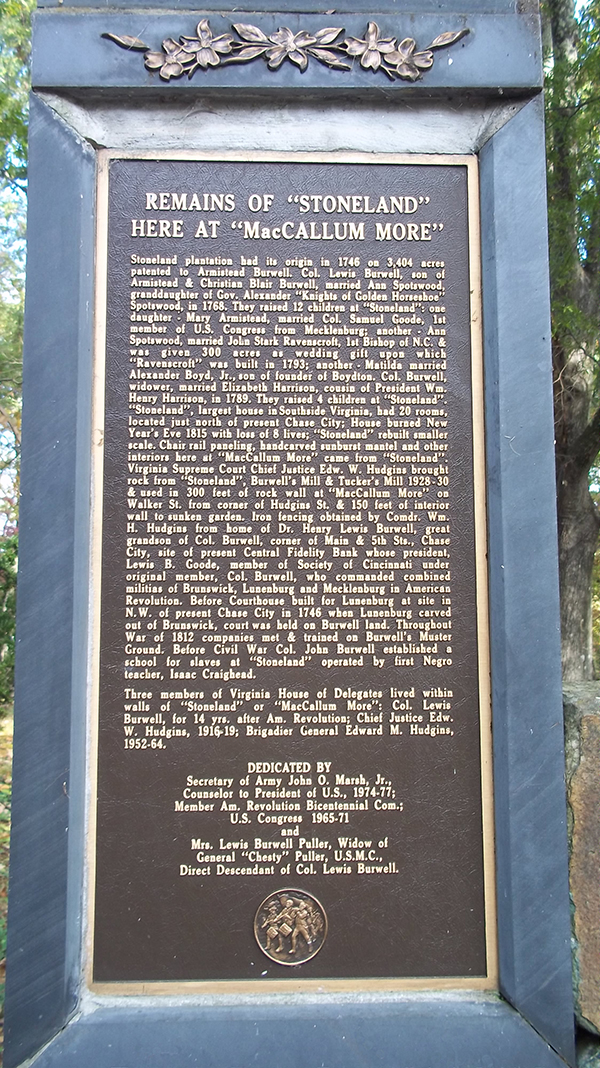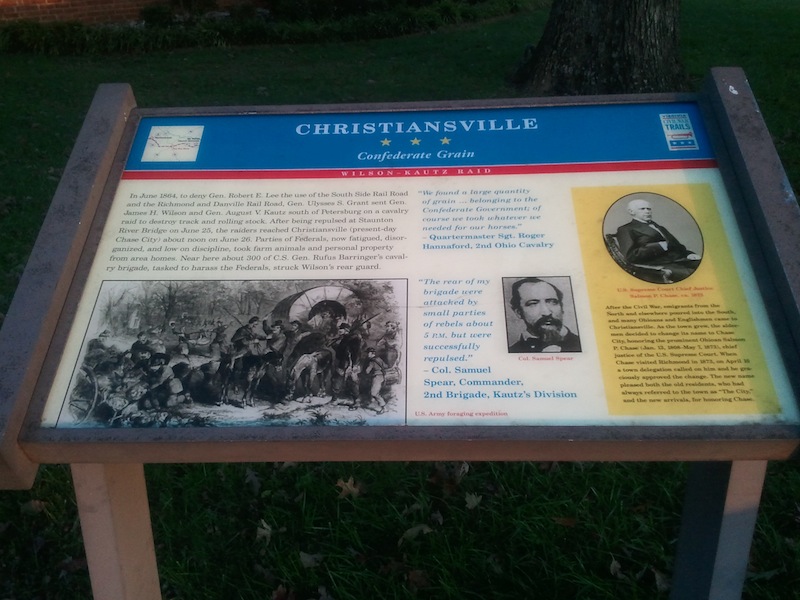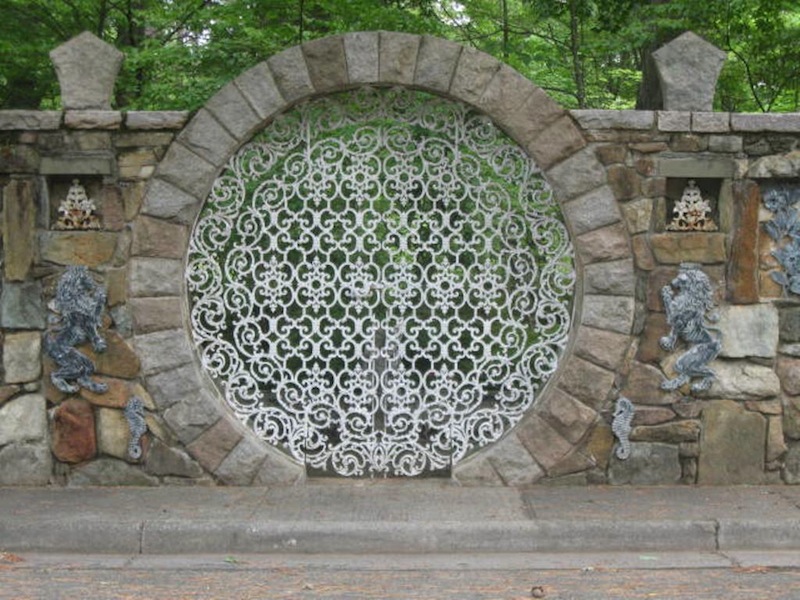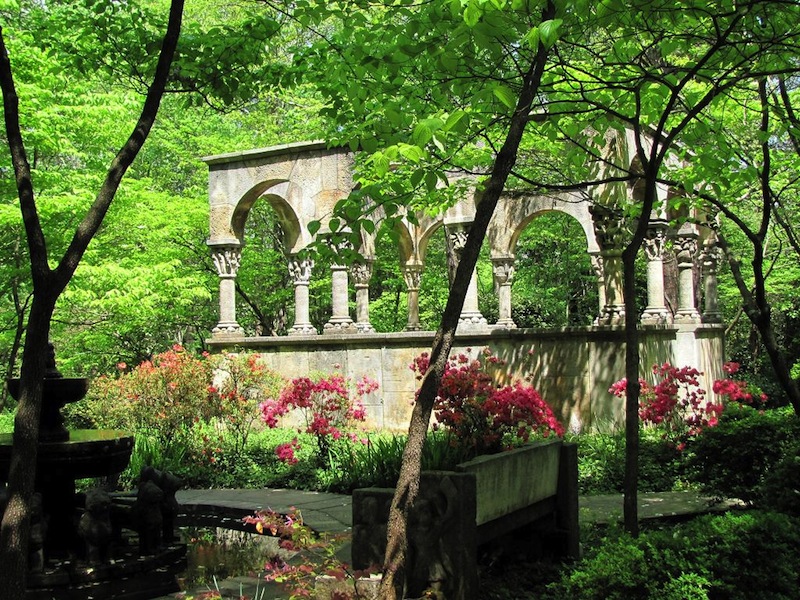MacCallum More Museum & Gardens
Remains of Stoneland Plantation & nearby Civil War Trails marker for Christiansville at Butler Memorial Library
*National Register of Historic Places
Remains of Stoneland Plantation & nearby Civil War Trails marker for Christiansville at Butler Memorial Library
603 Hudgins St., Chase City, VA 23924
(434) 372-0502
Hours:
Monday - Friday: 10:00 am - 5:00 pm
Saturday: 10:00 am - 1:00 pm
Sunday: Closed
Major Holidays: Closed (unless otherwise posted)
Gardens open Daily for self-guided tour.
Fees: Yes. Please contact the MacCallum More office for admission fees, event information, rental information, meetings, educational classes, and group tours. Gardens will be closed for private functions and weddings. The Civil War Trails marker for Christiansville is located at the nearby Butler Memorial Library, 515 N. Marshall Street, Chase City.
In the heart of Chase City are approximately six acres of formal gardens, fountains, and beautiful statuary, including a 1st-century Roman bust, nestled in a woodland setting among 8,000 boxwoods--many from old homes in Southside Virginia, native dogwoods, and azaleas.
(434) 372-0502
Hours:
Monday - Friday: 10:00 am - 5:00 pm
Saturday: 10:00 am - 1:00 pm
Sunday: Closed
Major Holidays: Closed (unless otherwise posted)
Gardens open Daily for self-guided tour.
Fees: Yes. Please contact the MacCallum More office for admission fees, event information, rental information, meetings, educational classes, and group tours. Gardens will be closed for private functions and weddings. The Civil War Trails marker for Christiansville is located at the nearby Butler Memorial Library, 515 N. Marshall Street, Chase City.
The museum houses several permanent exhibits. The Arthur Robertson Exhibit contains Indian artifacts dated approximately 9500BC-1600AD; The Thyne Institute Exhibit tells the story of an African American boarding school established in 1876; and The Mecklenburg Hotel Exhibit contains memorabilia from the hotel, built in 1903, famous for its curative waters. The cabinet in the front hall houses local memorabilia and is from Elam's Jewelry Store, a long time business in Chase City. The newest exhibit details the founding of Estes Express Lines in Chase City in the 1930s and follows its growth to the present day.
The gardens are the result of at least four individuals--prominent landscape architect Charles Freeman Gillette (1886-1969), Lucy Morton Hudgins (1880-1964), her son William "Billy" H. Hudgins (1915-1986), and his nephew Howard Hudgins (1951-). The name, "MacCallum More", derives from Mrs. Hudgins' Scottish heritage. She is distantly related to the first Duke of Argyle, Archibald Campbell, and the seat of the head of the Campbell clan was called "MacCallum More". The gardens' impressive collection of worldwide artifacts is the result of tireless efforts by Billy Hudgins, Commander in the U.S. Navy and Naval Aide to President Truman and General Eisenhower as well as Admiral Robert B. Carney, Chief of Naval Operations (1953-1954). Hudgins collected artifacts from his extensive travels, having statues, fountains, gates, benches, urns, well heads and all sorts of other garden accessories shipped from various locations abroad.
The gardens are enclosed by walls constructed of stones from the chimneys and foundations of numerous 18th and 19th century buildings that once stood in the surrounding countryside. Of particular interest: Stones from the remains of Stoneland Plantation, north of Chase City, where before the Civil War, John Stark Ravenscroft Burwell (1813-1877) established a school for slaves, operated by the "first Negro teacher", Isaac Craighead (abt. 1845-????).
John Stark Ravenscroft Burwell was the grandson of Stoneland's founder, Colonel Lewis Burwell (1745-1800), who commanded a regiment in the Revolutionary War and served 14 years as a member of the Virginia Legislature. Colonel Lewis Burwell's first wife, Anne (also known as Ann) Spotswood Burwell (1752-1789), was granddaughter of Alexander Spotswood (circa 1676-1740), Lieutenant Governor/Acting British Colonial Governor of Virginia. The Burwells' Stoneland "complex" eventually included a grist mill, general store, iron mines and a forge, a sawmill, orchards, pastures, a still house, and hundreds of acres of productive tobacco and grain fields worked by as many as 200 slaves.
On page 34 of his book, The Burwells of Kingsmill & Stoneland: An Account Of An American Family 1633-1900, Robert Andrew Parker offers an account of the Burwells' move to Stoneland: "... the Finneywood area of Mecklenburg County was in fact still a frontier at the time, and life there would surely be different for Lewis and Anne, who had both spent most of their formative years in and around Williamsburg, where they enjoyed the refined and elegant society of their powerful families and friends, including the likes of Thomas Jefferson, Patrick Henry, George Washington, and the Lees, Pages, and Randolphs. So it must have been with some trepidation that this young couple faced the realities of the move to Stoneland and the area described by one of their peers as 'the dullest neighborhood in the whole world'." On page 35 Parker notes that "... Lewis and Anne made the best of the situation, and through additional property acquisitions and skillful management, Lewis's holdings grew over three decades to include ... over 9,000 acres in Mecklenburg, Lunenburg, and Franklin Counties."
Parker continues on page 35 with: "In order to insure the classical education of their children, they set up a boarding school at the Stoneland manor where John A. Fowlkes taught English, French, Latin, arithmetic, and writing. Page 329 of Susan Bracey's book, Life by the Roaring Roanoke, also refers to the Stoneland boarding school: "At times a parent would elect to take children as boarders to offset the cost of the teacher, rather than to hire him jointly with other parents. Colonel Lewis Burwell, much to his displeasure, found it necessary to do this. John A. Fowlkes had probably been keeping his school at Burwell's since he had begun living there in January 1796. In July, Fowlkes and Burwell announced that the school would be continued the next year if enough boarders could be obtained. Burwell, having no other solution available would 'subject himself to the inconvenience of boarding eight or ten boys ... they finding their own bed ..., which may be made easy by those who send their sons joining, as one bed will serve two boys'." In addition, Bracey notes that Fowlkes was considered by many "to be very capable ..."
Parker elaborates on the cultivated tastes of the Burwell family at Stoneland with the following on page 35: Lewis and Anne also recreated the formal lifestyle into which they had been born and to which they had grown accustomed in Williamsburg ..., and they insured that these customs and social graces set the tone and the standard of gentility for their family at Stoneland." Parker continues on pages 35 and 36, describing the Burwell library at Stoneland, indicating that it "... told something of Lewis and Anne's classical education, diverse interests, and their class' lingering ties to England. Among several hundred books there were eight volumes of HUME'S HISTORY OF ENGLAND, two on the history of California, eight volumes of THE SPECTATOR, books on religion, geography, and the writings of Plutarch, Euclid, and Montaigne." Parker adds on page 36: "Imported Queen's china, silver ware, furniture, art, clothes, and customs all served as a back drop to what was certainly a grand lifestyle, duplicating in many respects that of the English gentry."
A related plaque, on the exterior wall at Walker Street reads:
REMAINS OF "STONELAND" HERE AT "MacCALLUM MORE"
Stoneland plantation had its origin in 1746 on 3,404 acres patented to Armistead Burwell. Col. Lewis Burwell, son of Armistead & Christian Blair Burwell, married Ann Spotswood, granddaughter of Gov. Alexander "Knights of the Golden Horseshoe" Spotswood, in 1768. They raised 12 children at "Stoneland": one daughter - Mary Armistead, married Col. Samuel Goode, 1st member of U.S. Congress from Mecklenburg; another - Ann Spotswood, married John Stark Ravenscroft, 1st Bishop of N.C. & was given 300 acres as wedding gift upon which "Ravenscroft" was built in 1793; another - Matilda married Alexander Boyd, Jr., son of founder of Boydton. Col. Burwell, widower, married Elizabeth Harrison, cousin of President Wm. Henry Harrison, in 1789. They raised 4 children at "Stoneland". "Stoneland", largest house in Southside Virginia, had 20 rooms, located just north of present Chase City; House burned New Year's Eve 1815 with loss of 8 lives; "Stoneland" rebuilt smaller scale. Chair rail paneling, hand carved sunburst mantel and other interiors here at "MacCallum More" came from "Stoneland". Virginia Supreme Court Justice Edw. W. Hudgins brought rock from "Stoneland", Burwell's Mill & Tucker's Mill 1928-30 & used in 300 feet of rock wall at "MacCallum More" on Walker St. from corner of Hudgins St. & 150 feet of interior wall to sunken garden. Iron fencing obtained by Comdr. Wm. H. Hudgins from home of Dr. Henry Lewis Burwell, great grandson of Col. Burwell, corner of Main & 5th Sts., Chase City, site of present Central Fidelity Bank whose president, Lewis B. Goode, member of Society of Cincinnati under original member, Col. Burwell, who commanded combined militias of Brunswick, Lunenburg and Mecklenburg in American Revolution. Before Courthouse built for Lunenburg at site in N.W. of present Chase City in 1746 when Lunenburg carved out of Brunswick, court was held on Burwell land. Throughout War of 1812 companies met & trained on Burwell's Muster Ground. Before Civil War Col. John Burwell established a school for slaves at "Stoneland" operated by first Negro teacher, Isaac Craighead.
Three members of Virginia House of Delegates lived within walls of "Stoneland" or "MacCallum More": Col. Lewis Burwell for 14 yrs. after Am. Revolution; Chief Justice Edw. W. Hudgins, 1916-19; Brigadier General Edward M. Hudgins, 1952-1964.
DEDICATED BY
Secretary of Army John O. Marsh, Jr.,
Counselor to President of U.S., 1974-77;
Member Am. Revolution Bicentennial Com.;
U.S. Congress 1965-71
And
Mrs. Lewis Burwell Puller, Widow of
General "Chesty" Puller, U.S.M.C.,
Direct Descendant of Col. Lewis Burwell.
Page 248 of Life by the Roaring Roanoke, offers more information on aforementioned African American educator Isaac Craighead and the Burwell School: "... before the Civil War, John Burwell, whose plantation was near Christiansville, is said to have held a school for his slaves in the plantation kitchen. After the War Between the States, education for the freedmen began to develop slowly, as one or two room school buildings for Negroes started to spring up across the county. The freedmen, thirsting for an education, attended these schools in abundance, as much as their work would allow. On the Burwell plantation, a one-room frame structure replaced the old log building 'and Isaac Craighead became the first Negro teacher in the school.' Long known as the Burwell School, it was located near the village of Finneywood..."
Pages 61 and 62 of Chase City and Its Environs by Douglas Summers Brown, offer more information on Stoneland and its manor house, indicating that "... it once stood on highway #49 three miles north of the present Chase City. It was one of the most imposing places in this region. The Burwell family was one of the wealthiest and most noted in early Virginia." Brown's book also offers on pages 62 and 63 a "Copy of a Letter about Stoneland", dated 1816, from Mrs. E.B. Kennon to Miss Rachel Mordecai of Warrenton, North Carolina. This letter primarily recounts the events of the "devouring flames" and "dreadful conflagration" as 1815 ended and 1816 began at Stoneland, in which "eight persons were destroyed". The letter notes that four of those who perished in the fire were "Negro girls who slept in the house", while the others were Colonel Lewis Burwell's first son from his second marriage to Elizabeth Randolph Harrison (1759-1824)--Henry Harrison Burwell (1790-1816), his wife--Catherine Buford Burwell (????-1816), and two children--one a child, mostly likely Harriet, of Peyton Randolph Burwell (1792-1840)--the second son of Colonel Lewis Burwell and Elizabeth Randolph Harrison, and the other being a daughter, most likely Mary, of John Spotswood Burwell (1776-1855)--the second son of Colonel Lewis Burwell and Anne Spotswood Burwell. Kennon also refers to the resourcefulness of Martha Christian Burwell (1795 to about 1850), the youngest child of Colonel Lewis Burwell's second marriage. Kennon writes: "By the time Martha had been made sensible of her danger, the flames roared through the upper passage and came in at her door." Kennon notes that Martha "... shut the door as a barrier against fire, took a little Negro girl who was in the room with her, and putting her as far as possible out of the window frame to break her fall, she called for some person to try to catch her." Kennon continues: "A Negro woman heard and ran to assist her. She then let go the window and scraping down the side of the house prevented herself from descending with as great rapidity as she would otherwise have done. The servant caught her, but the weight broke one of her arms, while Martha escaped injury except wounding her hand with a nail, it is supposed, which was perhaps in a plank." Kennon notes that a "... young gentleman leaped after her, but not using the same wise precaution, he was so hurt by the violence of the concussion that he was taken up insensible and did not speak for several days." Kennon ends her letter with "P.S. The little Negro, ... did not get hurt when put out the window." Robert Andrew Parker also quotes Kennon's letter, adding on pages 83 and 84 of his book: "The Negro girl who probably saved Martha's life by breaking her fall was Fanny, who was born at Stoneland and who was then only sixteen years old."
Also in the vicinity of MacCallum More Museum & Gardens is a nearby Civil War Trails marker, associated with the Wilson-Kautz Raid, at Butler Memorial Library (515 N. Marshall Street), noting the significance of Christiansville (original name of Chase City) and Confederate grain. The marker references the significance of fatigued and disorganized parties of Federals, who, following the route at Staunton River Bridge, took farm animals and personal property from area homes.
This nearby Christiansville marker reads:
In June 1864, to deny Gen. Robert E. Lee the use of the South Side Rail Road and the Richmond and Danville Rail Road, Gen. Ulysses S. Grant sent Gen. James H. Wilson and Gen. August V. Kautz south of Petersburg on a cavalry raid to destroy track and rolling stock. After being repulsed at Staunton River Bridge on June 25, the raiders reached Christiansville (present-day Chase City) about noon on June 26. Parties of Federals, now fatigued, disorganized, and low on discipline, took farm animals and personal property from area homes. Near here about 300 of C.S. Gen. Rufus Barringer's cavalry brigade, tasked to harass the Federals, struck Wilson's rear guard.
The marker also features these quotes:
"We found a large quantity of grain ... belonging to the Confederate Government; of course we took whatever we needed for our horses." - Quartermaster Sgt. Roger Hannaford, 2nd Ohio Cavalry; "The rear of my brigade were attacked by small parties of rebels about 5 P.M. But were successfully repulsed." - Col. Samuel Spear, Commander, 2nd Brigade, Kautz's Division.
The marker's sidebar reads:
After the Civil War, emigrants from the North and elsewhere poured into the South, and many Ohioans and Englishmen came to Christiansville. As the town grew, the aldermen decided to change its name to Chase City honoring the prominent Ohioan Salmon P. Chase (Jan. 13, 1808-May 7, 1873), chief justice of the U.S. Supreme Court. When Chase visited Richmond in 1873, on April 10 a town delegation called on him and he graciously approved the change. The new name pleased both the old residents, who had always referred to the town as "The City," and the new arrivals, for honoring Chase.
Contributors: Liz Lowrance, Event Coordinator & Trustee of MacCallum More Museum & Gardens & Leigh Lambert, Director of Southside Regional Library
Websites:
http://www.mmmg.org/
http://www.virginia.org/Listings/HistoricSites/MacCallumMoreMuseumandGardens/
Sources:
Full Sources for Historic Sites [pdf]
http://www.mmmg.org/
http://www.virginia.org/Listings/HistoricSites/MacCallumMoreMuseumandGardens/
Sources:
Full Sources for Historic Sites [pdf]
(c) Copyright 2014. All Rights Reserved. Designed by Jason Winter ||



